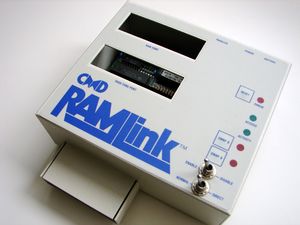RAMLink
From C64-Wiki
Jump to navigationJump to search
| RAMLink | |

| |
| Device Name: | RAMLink |
| Manufacturer: | Creative Micro Designs |
| Media Type: | RAM, 4× 30-pin SIMM slots. |
| Storage Capacity: | 1 – 16 MB |
| Release Price: | |
| Released: | 1990 |
| Discontinued: | 2001 |
| Processor: | |
| RAM: | |
| ROM: | |
| Data Bus: | System bus |
| Data Connector: |
|
| Power Requirements: | 9V @ 1 Amp |
| Power Connector: | |
| Firmware: | RL-DOS |
| License: | Proprietary |
| Manual: | |
| Predecessor: | {{{Predecessor}}} |
| Successor: | {{{Successor}}} |
| Info: | Marketed with the PPI RAM Drive. |
The RAM Link was a RAM based storage device created by Creative Micro Designs to accomplish a number of goals. It was built to be compatible with the C64 and C128.
- Battery backed RAM disk: Unlike a plain REU the RAMLink had a battery which allowed it to retain stored information even when the power was off.
- High capacity storage: The RAMLink could be paired with as much as 16MB RAM, in the form of 4×4 30-pin SIMM cards.
- Compatibility via Disk Emulation: The RAMLink could support many partitions, including those emulating 1541, 1571, and 1581 floppy drives. This gave ordinary programs that were never written with compatibility in mind the ability to be stored on a RAM based device.
- REU Compatibility: The ability to attach an ordinary REU to the RAMLink for those few applications that directly addressed them.
- Cartridge pass though: thus not requiring the user to choose between their favorite cartridge and the RAMLink.
- JiffyDOS support out of the box.
- CMD HDD support: even without RAM expansion the RAM Link could drive an attached CMD HDD via the system bus instead of the serial bus increasing data transfer speeds significantly.
- Real Time Clock: the RAMLink had an optional RTC.
The RAMLink was extremely advanced for its time. But, it was not without its drawbacks. These included:
- High price: just for the RAMLink, RAM chips cost extra and drove the effective price much higher. In fact, the RAMLink cost more money than the SuperCPU, though the two devices were compatible.
- Large footprint: the RAMLink was much larger than an ordinary cartridge. Further, the dual cartridge port — one REU and one pass-through — were vertically oriented adding height to the machine.
- Copy protection issues: Games that were heavily copy protected would be difficult to transfer to the RAMLink or any large scale storage device.
- Proprietary cables: the parallel cable between the RAMLink and the CMD HDD was not a standard design - the floppy cable of the ATARI ST series.
- REU Extra: Programs actually written to support an REU required the RAMLink to be either in an REU mode (flushing data from the device) or to use an ordinary REU attached to the device. The RAMLink was marketed with the RAM Drive for just this purpose as it supported a maximum of 2MB.
- RAMLink lacked support for 1571's burst mode over the cartridge port. Any software that required this functionality would fail.
Links[edit | edit source]
| Wikipedia: CMD_RAMLink |